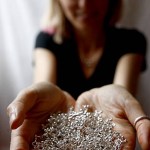Science
Photo: Jana Asenbrennerova / The Chronicle
SFGate has a great interview with Raven Hanna of madewithmolecules! I love Raven's stuff an am thrilled to see her getting recognition.
Camponotus rosariensis tending scale insects in Argentina
Another piece of the Camponotus hyperdiversity puzzle was published this week in BMC Evolutionary Biology. The reasons behind the tremendous richness of Camponotine ants- a worldwide group of conspicuous insects containing more than a thousand species- are unknown, but recent explanations have focused on the nutritional relationship between the ants and their endosymbiotic Blochmannia bacteria. These gut-dwelling microbes may have allowed camponotines to capitalize on honeydew resources nutritionally unavailable to other ants,…
I gave a talk last night to the Albany Area Math Circle, a group of high-schoolers who are interested in science and math, and enter and do very well in national math competitions. I think there were 48 kids there last night, which was pretty impressive.
I gave basically the same talk I gave at Boskone on the Many-Worlds Interpretation, including reading the dog dialogue from Chapter 4. I made an effort to update the SF references a little, to things that people born in the early 1990's might recognize. (Wow, I feel old.)
The talk was probably a little too abstract for the audience, and I…
Since I happen to have fallen into the topic of anthropogenic global warming, before I move back to medical topics I might as well have a little fun. Certainly, I could use some, given that I just wrote two posts in which I felt forced to criticize someone whom I admire greatly. Besides, it's been over a week since I last blogged about vaccines on this blog. that has to be some sort of record. Why wreck it now? It feels good to take a break from the topic, and there's always next week. I have no doubt that the anti-vaccine movement will produce something begging for some not-so-Respectful…
How to Teach Physics to Your Dog is now listed as "In Stock" at Amazon, so it's the perfect time to order a dozen or so copies for your last-minute holiday gift needs.
"But, wait," you say, "why do I want to teach my dog physics? Particularly quantum physics-- why does anyone need to know that?"
The answer is: "Lasers." Lasers are pretty awesome, right? Let's ask an expert:
If I were creating the world I wouldn't mess about with butterflies and daffodils. I would have started with lasers, eight o'clock, Day One!
OK, maybe he's a bad one to ask. Still, lasers are pretty awesome, and lasers…
I've been dimly aware that physics in the UK was being hit hard by a financial crisis for a while now. It seemed to be a bit deeper than what people in other countries complain about, but I hadn't given it much thought until I read this Physics World story on the latest cuts, which includes the following explanation:
The origin of the cuts can be traced back to December 2007 when the STFC announced that it had an £80m budget deficit for the UK government's current spending round that lasts from 2008 to 2011. It is thought that the deficit emerged by an accounting mistake was made when the…
As a physicist with a blog, I am contractually obligated to do a post on the CDMS almost-a-result. This is that post.
The short version: they expected at most 0.8 events (that's total events, not events per day, or anything-- this is a whole community built on detecting nothing at all), and got 2, with maybe a third that was close to making the cut, but didn't. I think Joe Fitzsimons on Twitter summed it up best, writing:
Isn't that the least informative number of events possible?
It's more events than expected, but not enough to really be meaningful. The probability of this level of signal…
Yesterday, I wrote one of my typical Orac-ian length posts that was unusual. What was unusual about it was not its length. Rather, what was unusual about it was the target of its criticism, perhaps one of the last people in the world I would ever have expected to have to have taken issue with, James Randi himself, who had posted a truly embarrassing post in which he cast doubt upon anthropogenic global warming (AGW). What provoked my dismay was not so much that Randi had questioned AGW; what dismayed me so was how he did it. His post, as I pointed out, was chock full of logical fallacies and…
A question I used to get fairly frequently is "what medical advance has saved the most lives?" Guesses usually include antibiotics, vaccines, and septic surgical method, but it's probably. . . clean water. Not a medical advance, you say? Maybe not, at least the way most people think of medicine - but sadly there are still many parts of the world that can't take clean water for granted.
Via John at Tracing Resistance Blog.
Since we're arguing over global warming this week, I thought I'd post a commentary piece that was published in the Morris newspaper this week, by my colleague Pete Wyckoff. Pete is our local tree and climate expert, who works in both the biology and environmental studies discipline, and is very well qualified to describe what was going on with some of the adjustments in the climate data that have some of the nuts screaming shrilly on Fox News.
Local Commentary: Thoughts on 'Climate-gate': Mitigate our impact
By Pete Wyckoff
Is the planet cooling? "I've just completed Mike's Nature trick…to…
Quantum physics can sometimes seem so arcane that even humans don't need to worry about it, let alone dogs. It's actually tremendously important to our modern world. In fact, if you're reading this on a computer (and how else would you be getting it?), you have quantum physics to thank for it.
Computers are based on millions of tiny transistors manufactured on chips of silicon. These transistors are combined together to make "bits" that can be in one of two states, which we call "0" and "1." Manipulating these bits lets us do mathematical operations, write books about dogs, and watch videos…
We've returned from the 2009 Entomological Society of America meeting in Indianapolis. More on this later.
For now, here are slides from two presentations I gave yesterday:
Character Evolution in Heterospilus
Origin of Pheidole obscurithorax
Both talks report from ongoing research, so I should caution that neither of the studies has seen peer-review.
At the ScienceOnline 2010 conference next month, I'm going to be on a panel about "Rebooting Science Journaiism," in which I'll join Carl Zimmer, Ed Yong, and John Timmer in pondering the future of science journalism. God knows what will come of it, as none of us have the sure answers. But that session, as well as the entanglement of my own future with that of science journalism, has me focused on the subject. And two recent online discussions about it have piqued my interest.
One was the reaction, on a science writer's email-list I'm on, to a recent Poynter interview with Times science…
Yesterday's reason to love quantum was the CCD sensor, which relies on the photoelectric effect to take digital pictures. Sticking with the photoelectric theme, today's first quantum-enabled technology is the photovoltaic cell, the basis for solar panels.
Photovoltaic cells convert light into electricity, essentially via the same photoelectric effect used in CCD's. A photon of light comes along, and knocks an electron out of some material (typically something silicon-based), and that electron is used to create a current that can power electrical devices. There's some tricky business involved…
Remember how yesterday I said that sometimes writing this blog depresses me? At the time, I made that observation because there are times when the unending constant onslaught of pseudoscience, anti-science, and woo leads me to despair that the human race will ever overcome its cognitive defects. However, there are other times when blogging depresses me. It's for an entirely different reason, though. There are times when people I admire, people who should know better, fall and fall hard. No, I don't mean Tiger Woods getting it on with a bunch of blondes. The level of horniness and lack of…
I've been writing a bunch of publicity copy for the book the last few weeks, and one of those things is a list of reasons why every dog should know about quantum physics. I've been planning to chop that up into a bunch of individual blog posts in the run-up to the book, but the Washington Post beat me to (one of) the punch(es):
Getting a digital camera for Christmas? Before you fire it up to capture Uncle Wally's fateful fifth trip to the punch bowl, take a moment to picture this: You've got a genuine scientific marvel in your mitts. In fact, it took nothing less than two Nobel prizes and a…
While I'm thrilled to see How to Teach Physics to Your Dog listed on Amazon, I am distressed to see it offered as a pair with something called The Intention Experiment by Lynne McTaggart. I'm not linking to the Amazon page for that book, because it's a giant pile of crap, and I wouldn't want anyone to accidentally one-click-order it after following a link from my page.
If you should choose to look it up, you can read bits and pieces of it via the "Look Inside" feature, and it's true that the opening chapter or so is a reasonable-sounding description of the physics of quantum entanglement,…
It's exactly one week to the release date for How to Teach Physics to Your Dog, and to celebrate, I'm setting off on an expedition to the local mall(s) in search of Christmas presents. May God have mercy on my soul...
Anyway, I wouldn't want you to be without entertainment while I'm off helping the economy, so here's another little video to mark the one-week anniversary. This one is the dog dialogue from Chapter 5, on the quantum Zeno effect, and while it doesn't have puppets, it does feature some happy dog video, before settling down into still pictures and graphics:
We're at the point, now…
There was a question from Jerry in a previous post:
"A simple question for which I can't find an answer: Why do you have to collimate light spectroscopy? What would happen if you didn't collimate it?"
The basic idea of spectroscopy is to look at the different colors of light coming from some source. Typically light from a source (like an excited gas) is passed through a diffraction grating that makes different colors bend different amounts (like a prism, only better).
Collimated light is basically light that is all going the same direction. How about I go ahead and draw a picture. This is…

